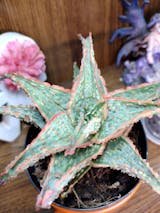Succulent Watering Tips
Share
How Often Should You Really Water Succulents? (Avoid These 3 Common Mistakes)
One of the most frequent questions succulent owners ask is, "How often should I water my succulents?" Proper watering is crucial to keeping your succulents healthy and thriving. Here’s a simple, clear guide based on proven methods from my book, Succulent Style, to ensure your succulents always look their best.
How Often Do Succulents Need Water?
Succulents store water in their leaves, stems, and roots, allowing them to go longer periods without water. Typically, succulents thrive when their soil is allowed to dry out completely between waterings. Here’s a quick rule of thumb:
-
Indoor succulents: Generally, water every 10–14 days, adjusting based on temperature and humidity.
-
Outdoor succulents: Usually water once a week, but more frequently during hot, dry weather.
Avoid These 3 Common Succulent Watering Mistakes
1. Misting Instead of Drenching
Many beginners mistakenly believe succulents like misting. However, misting only dampens the surface, preventing roots from absorbing enough water.
What to do instead: Thoroughly drench the soil until water drains from the bottom of the pot. Then allow the soil to completely dry before watering again.
2. Overwatering
Succulents do poorly with constantly moist soil. Signs of overwatering include yellowing leaves, soft or mushy leaves, and stem rot.
What to do instead: Check soil dryness by inserting your finger about an inch deep. Water only if the soil feels completely dry.
3. Ignoring Seasonal Changes
Succulents have different water needs depending on the season. They often need more water in summer and much less in winter when they're dormant.
What to do instead: Adjust watering schedules seasonally. Increase water frequency slightly in hot summer months and decrease significantly during cooler winter months.
Quick Succulent Watering Tips
-
Use pots with drainage holes to prevent waterlogging.
-
Choose fast-draining succulent soil mixtures, typically containing perlite or pumice.
-
Observe your plants closely; shriveled, wrinkled leaves mean your succulent is thirsty, while soft, translucent leaves mean it’s getting too much water.
Easy Troubleshooting
-
Wrinkled, shriveled leaves? Give your succulent a deep watering.
-
Yellow, mushy leaves? Let the soil dry completely, repot into fresh soil if necessary, and reduce your watering schedule.
Following these simple guidelines from Succulent Style will help ensure your succulents stay healthy, vibrant, and beautiful. Happy gardening!
A Few Additional Tips
Because succulents store water inside their stems and leaves, another way to know if they need water is by the feel and look of their leaves. Hydrated succulent leaves look plump and feel firm. The leaves will spring back if you cup your hand around the plant gently, pressing the leaves together, then letting them go. If the plant doesn’t feel stiff and the leaves don’t spring back quickly, the plant needs water. If leaves have prune-like wrinkles or they feel leathery when you cup your hand around the plant, it’s time to water. Succulents handle high temperatures better when their leaves are plump with water.

Photo of a hand cupped around a succulent to test for leathery leaves
It’s always best to water first thing in the morning. If the weather’s hot, the sun heats up the soil. Watering hot soil damages roots and can kill succulents. And watering in the morning gives water a chance to evaporate off the leaves before the sun goes down. Water that collects on leaves and sits all night can cause black fungus to grow on the leaves. This might not be a concern if you live in a hot, dry climate and water evaporates without sunshine.
Another tip for growing succulents in scorching climates is to plant your succulents in terra cotta garden pots, instead of plastic or hard-fired ceramic pots. Plastic pots and glazed ceramic containers hold heat like an oven that exacerbates high temperatures.

Graptoveria ‘Jules’
Many succulents have beautiful yellow leaves. Don’t assume that every yellow succulent is overwatered. Some succulents are variegated, with leaves that have yellow and other colors. One succulent I’m thinking of is the Graptoveria ‘Jules’. It has an outer row of yellow leaves, and its other leaves are pink!


